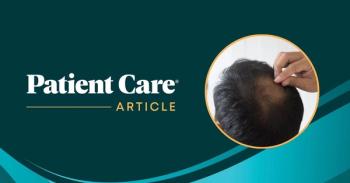
Infundibular Cyst
Concerned about this unsightly and painful lesion, a 34-year-old man asked to have it removed. The patient first noted this eruption on his back several months before. This lesion is an infundibular cyst.
Concerned about this unsightly and painful lesion, a 34-year-old man asked to have it removed. The patient first noted this eruption on his back several months before. This lesion is an infundibular cyst.
The majority of keratinizing cysts are infundibular, write Drs Charles E. Crutchfield III, Eric J. Lewis, and Humberto Gallego of St Paul. They arise spontaneously from the infundibular (funnel-shaped) portion of the pilosebaceous unit and are frequently termed “epidermal inclusion cysts.” Infundibular cysts primarily occur on the face; neck; chest; periauricular areas; and genitalia, where they have a tendency to calcify.
Seen in men approximately twice as often as in women, these cysts can measure from 3 mm to several centimeters in diameter. Many contain a small punctum that marks the connection of the cyst to the overlying epidermis, either by the pilar canal of a follicle or by a sinus tract. Often, infundibular cysts rupture, causing suppuration that is foul-smelling, foreign-body granulomatous reaction, and/or granulation tissue with chronic inflammation.
This patient's cyst was extracted through an overlying incision, which is the standard therapy for these lesions.
When infundibular cysts are excised, the entire surrounding sac that contains cystic material must be removed to prevent recurrence.
FOR MORE INFORMATION:
- Dover JS, Jackson BA. Pocket Guide to Cutaneous Medicine and Surgery. Philadelphia: WB Saunders Company; 1996.
Newsletter
Enhance your clinical practice with the Patient Care newsletter, offering the latest evidence-based guidelines, diagnostic insights, and treatment strategies for primary care physicians.






























































































































































































































































































































